Antarctica is the most inhospitable piece of land in the world. Temperatures rarely go above 15 degrees Fahrenheit and drop to insanely cold temperatures during the winter. But have you ever wondered where the coldest temperature ever recorded on earth was? The honor goes to Vostok Station in Antarctica. There, the mercury once dropped to a frigid minus 128.6 degrees Fahrenheit (−89.2 °C)!
Vostok Station is located in Princess Elizabeth Land, Antarctica. It is one of the most remote and inhospitable places. This makes it the perfect spot to set the record for the coldest temperature ever recorded.
History and Discovery of Vostok Station, Antarctica
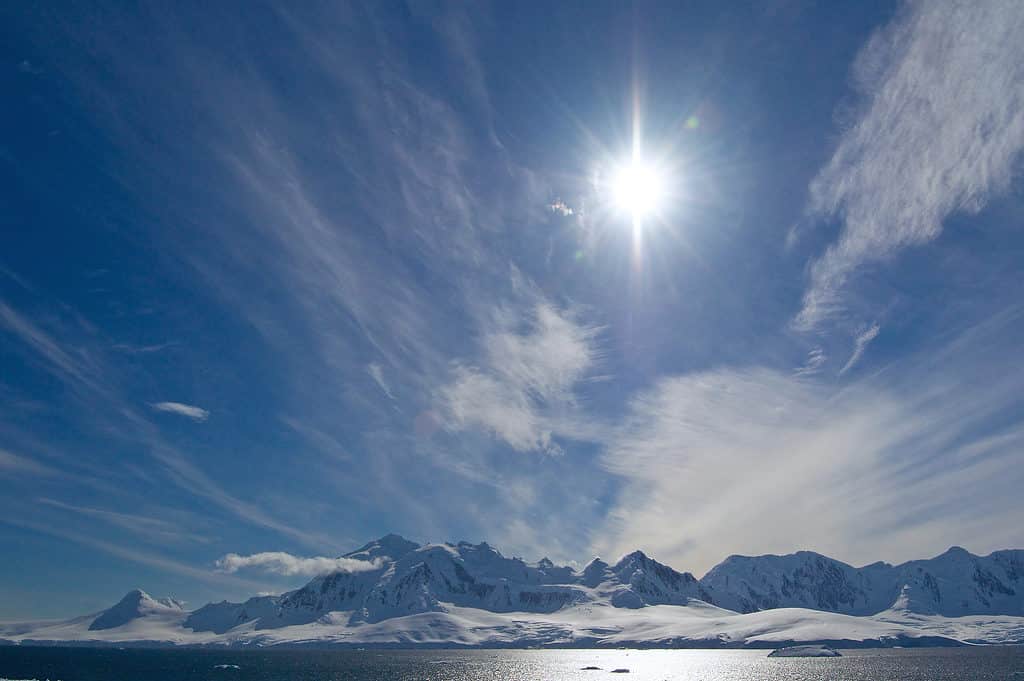
Covered in ice, Antarctica is the coldest place on Earth.
©iStock.com/jin_tang
Antarctica is the southernmost continent on Earth. It’s covered in ice and has extremely cold temperatures and harsh weather conditions. It is the fifth largest continent, mostly uninhabited, with no permanent residents.
Way back in 1773, James Cook and his crew made history by crossing the Antarctic Circle for the first time. Although they stumbled upon some isolated islands, they didn’t find the continent itself.
In 1820, a Russian crew led by Bellingshausen made history by crossing the Antarctic Circle for the second time ever. The next day, they became the first people to lay eyes on an unknown continent. It went unrecognized, though, due to a mistake in translating Bellingshausen’s journal. A year later, explorer and sealer John Davis made history by being the first person to actually set foot on Antarctica. That moment finally proved that the seventh continent was real.
Founded by the 2nd Soviet Antarctic Expedition in 1957, Vostok Station operated all year round for over 37 years. The station had to shut down for a short period of time in 1962, 1994, and 2003.
In 2019, the Russian government began the construction of a new, modern building for the purpose of replacing aging station facilities. Due to delays, the new station will not be compliant until late 2023 at the earliest.
Discovery of Lake Vostok
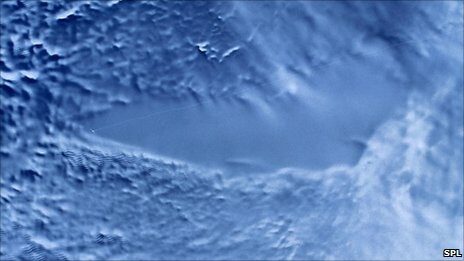
The discovery of Lake Vostok in Antarctica was made public in 1993.
©Goddard Space Flight Center / This file is in the public domain in the United States because it was solely created by NASA. NASA copyright policy states that “NASA material is not protected by copyright unless noted”. (See Template:PD-USGov, NASA copyright policy page or JPL Image Use Policy.)
In 1974, British scientists conducting a survey in Antarctica picked up unusual radar readings but didn’t immediately think of a lake beneath the ice. In 1991, a researcher at University College London used a satellite to confirm the discovery from 1974. It wasn’t until 1993 that the discovery of the lake, named Lake Vostok, was made public.
Antarctica has approximately 140 subglacial lakes, the largest of which is the subglacial lake in this region. In 1996, Russian and British scientists used various data, including radar imaging and altimetry, to identify the lake. It covers a surface area of approximately 5,400 square miles and is located about 13,000 feet below the Antarctic ice sheet.
Fun Facts About Vostok Station, Antarctica
- An Antarctic research station located at 3,488 meters (11,450 feet) above sea level, Vostok Station is among the most remote on the continent.
- Two scientists fought over a chess game at Vostok Station in 1959. One used an ice axe to attack the other. This led to the banning of chess games at Soviet/Russian Antarctic stations.
- Antarctica has high winds, with some areas experiencing them as strong as 200 mph (320 km/h) on average.
- Estimates predict that if the Ice Sheet of West Antarctica were to melt completely, it would result in a rise in global sea levels by an average of 16 feet (5 meters).
Average Temperatures

The lowest temperature ever recorded on Earth was at Vostok Station in Antarctica, when on July 21, 1983, temperatures reached -128.6 degrees Fahrenheit.
©sergioluno/Shutterstock.com
Nestled deep in the heart of Antarctica, Vostok Station is a place of unparalleled extremes. With temperatures remaining well below freezing year-round, it is a place where even the bravest of souls must tread carefully. But it’s not just the cold that makes Vostok Station so unique – with an average annual precipitation of just 0.87 inches or 22 millimeters, it is also among the driest places on earth.
Despite its harsh conditions, Vostok Station is also one of the sunniest places on the planet. With more hours of sunshine than even the most sun-drenched locations in Australia, the Arabian Peninsula, and the Sahara, it’s a true desert of ice. In fact, it is considered the largest desert in the world. In December, which is the beginning of summer for Antarctica, the station experiences an astonishing 708.8 hours of sunshine – this is the highest total ever achieved in a calendar month. But as the polar night sets in from May to August (the winter months), the station is plunged into complete and total darkness.
April to September are the coldest months, while December and January are the “warmest”.
| Months | Average Temperature (F) |
|---|---|
| April – September | -61 to -72 |
| December – January | -27 (rarely above) |
The Coldest Temperature Ever Recorded
On July 21st, 1983, Vostok Station experienced the coldest air temperature ever recorded on Earth, a bone-chilling -128.6 degrees Fahrenheit. This is cold enough to give you frostbite almost instantly, and it is incredibly unsafe to go outside, even covered in warm clothing.
Living in Vostok Station when it recorded the lowest temperature ever would have been an incredibly difficult and challenging experience, requiring a high degree of physical and mental toughness. It’s a testament to the dedication of the researchers and scientists who choose to work in such extreme environments.
Life at Vostok Station
The Russian Vostok Station is a remote and isolated location that is cut off from the rest of the world for nine months of the year. Temperatures in this area can drop to a frigid -76 to -80 degrees Fahrenheit, making it inaccessible even for aircraft, as they risk freezing to the surface upon landing.
One of the first challenges that individuals at the Vostok Station must face is mountain sickness. At nearly 12,000 feet above sea level, the air there has as little oxygen as the summit of Mount Elbrus (the tallest mountain in Russia and the European continent). The symptoms of this condition vary from person to person and can include depression, involuntary tearing, nausea, vomiting, dizziness, hypoxia, and sleep apnea.
Accounts From Vostok Station Visitors
Sergey Bushmanov, a member of an Antarctic expedition, recalls, “Usually, people lose up to 5-10 kilos in their first month at Vostok. I saw a man get sick a few minutes after arrival. If he hadn’t been evacuated immediately, then he’d have died in a few days of hypoxia resulting from pulmonary edema.”
During a month on the station, film director Ekaterina Eremenko described the experience as being like breathing underwater. The caves where people lived under the snow also surprised her because they had no daylight, the facilities were very small, and she had to dress very warmly. It took her over 30 minutes to get dressed to go outside.
This is the everyday routine at the Vostok Station under normal circumstances, where the harsh conditions make for a challenging and unique living experience.
Researchers have to go through extensive physical and mental training to go to Antarctica, especially during the winter months. Living in a harsh, isolated place for an extended period can take a toll on humans. The experience can only be compared to astronauts living in space for extended periods.
Wildlife in Antarctica
Antarctica is a land of unique and varied wildlife, a place where the creatures that call it home have adapted to survive in some of the harshest conditions on Earth. Unlike any other continent, Antarctica is devoid of terrestrial mammals, but it teems with an array of marine life and birds. And when it comes to birds, Antarctica’s most famous inhabitants are the penguins.
Some animals that inhabit Antarctica are listed below.
Emperor Penguin
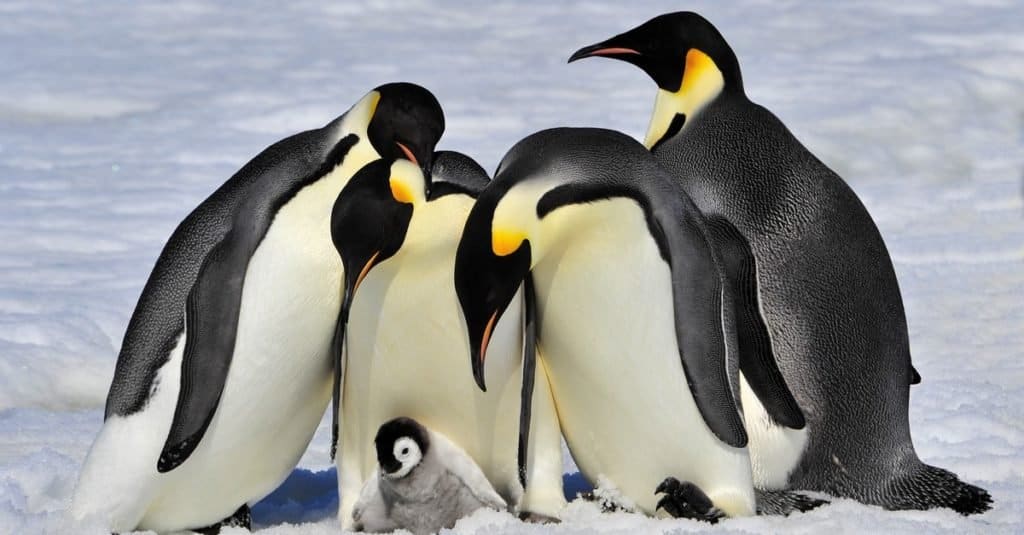
Huge colonies of emperor penguins dot Antarctica’s coastline.
©vladsilver/Shutterstock.com
With an average height of 130cm and weight of 23kg as adults, emperor penguins are truly unique creatures. They have remarkable physical adaptations that allow them to thrive in the harsh Antarctic environment, such as thick layers of feathers and blubber to insulate them from the cold.
Emperor penguins, the largest of all penguin species, are known for their huge colonies dotted along Antarctica’s coastline. Unlike other penguin species, emperor penguins have colonies on sea ice. The largest emperor penguin colony has more than 10,000 pairs, and the total population of emperor penguins in Antarctica is in the millions.
Orca
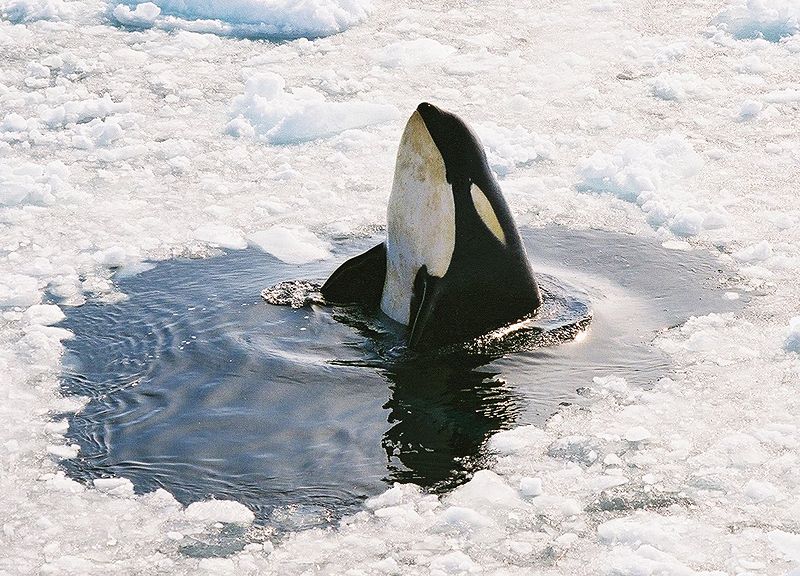
A diet of mostly seals helps orcas survive the harsh conditions of Anarctica.
©Jaime Ramos – Public Domain by National Science Foundation
Orcas, also known as killer whales, are some of the most powerful and feared predators on Earth. These fascinating creatures can reach lengths of almost 10 meters, making them the largest carnivores on the planet. They are found in all oceans but are particularly abundant around Antarctica.
In Antarctica, orcas have a diverse diet mainly consisting of seals, as they have a high-fat content that provides the necessary energy to survive in the year-round freezing temperatures. However, they are not limited to large meals. They also consume a variety of fish species. Their hunting tactics are complex and varied, and they use their intelligence and social bonds to work together and catch their prey.
Antarctic Krill
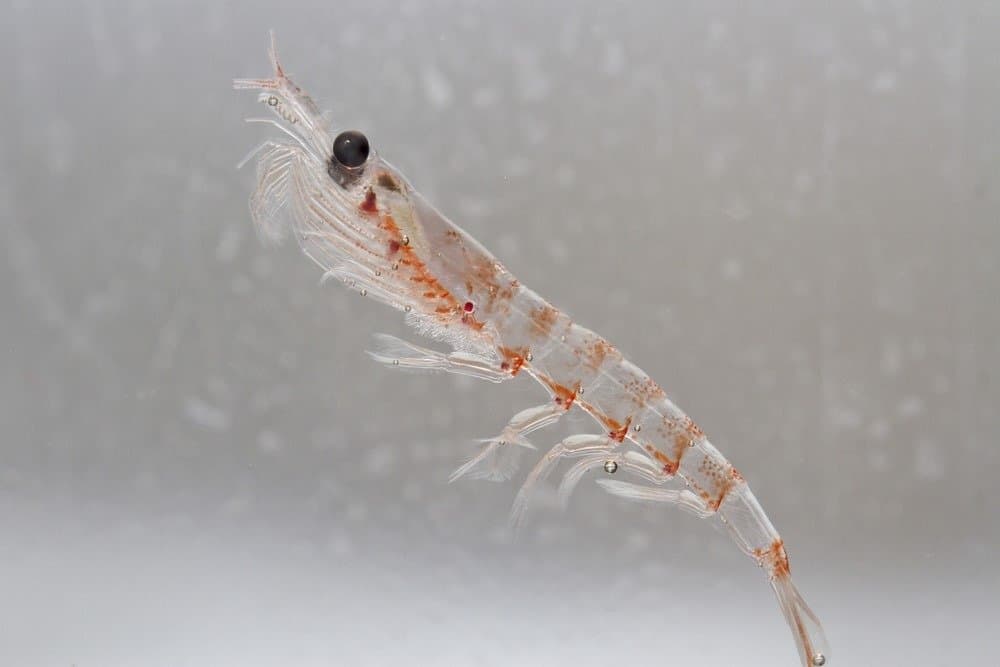
Five species of krill call Antarctica home.
©Tarpan/Shutterstock.com
Krill, small crustaceans that resemble miniature versions of prawns or lobsters, are an integral part of the Antarctic ecosystem. These shrimp-like creatures are found in five different species in Antarctic waters, with the most dominant species being the Antarctic krill (Euphausia superb).
Krill are active at night, feeding on the surface of the water. During the day, they sink deeper into the water column. Their primary food source is phytoplankton, tiny ocean plants that thrive in the upper water column where there is enough light for growth.
These small creatures play a big role in the Antarctic ecosystem as they are a vital food source for most of the larger Antarctic animals, such as squid, fish, seabirds, and seals, that depend on them directly or indirectly.
Seal
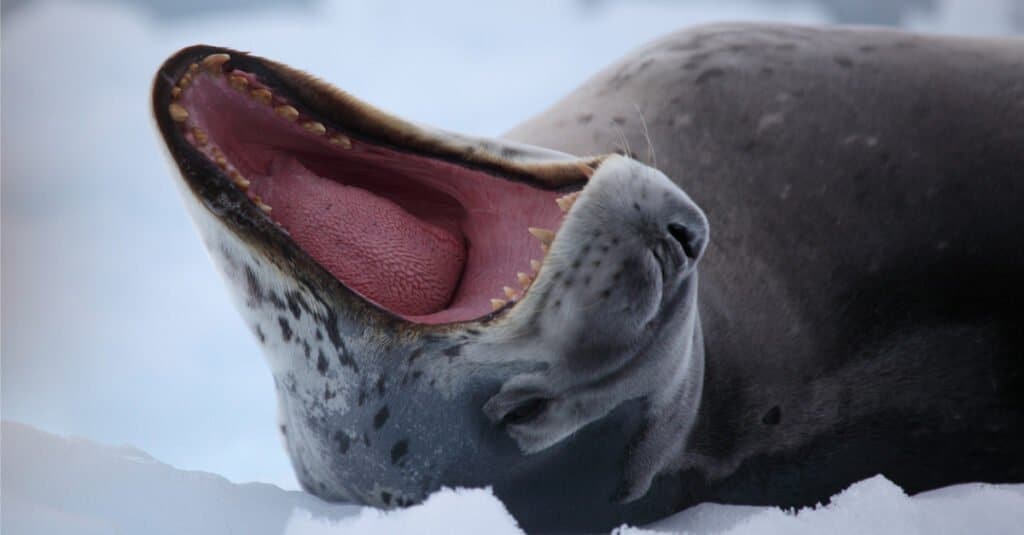
Leopard
seals are one of six seal species that live in Antarctica.
©iStock.com/MogensTrolle
Antarctica’s seals are expert hunters, known for their predatory skills and adaptability to the harsh polar environment. Depending on the species, they feed on penguins, krill, and even other seals. The leopard seal, in particular, is a voracious predator known for its diverse diet.
Seals are able to dive to depths of 1,600 feet in search of food, and they have developed specialized eyes that allow them to see in low light levels underwater. They also communicate with each other using vocalizations that can sometimes be heard above the ice.
Wildlife in Vostok Station
New discoveries in Lake Vostok, the largest subglacial lake in Antarctica, have revealed the presence of hydrothermal vents at the bottom of the lake. These vents pump energy and nutrients into the buried lake, potentially creating an ecosystem that supports a diverse range of life forms.
The discovery of microbial DNA that is similar to that found in animals has led scientists to speculate the presence of complex, multicellular organisms within the lake. However, it’s important to note that the evidence for this is still preliminary, and further research is needed to confirm the presence of animals in the lake.
Up Next
- What Is the Coldest Place on Earth, and Can You Survive?: Get to know the Eastern Antarctic Plateau in Antarctica! Discover exactly how cold it gets here and find out whether or not you’d be able to survive the extreme temperature!
- Discover the “Grand Canyon” No Person Has Ever Set Foot In: When you think of the Grand Canyon, you may think of a hot natural wonder in the United States, but did you know that Greenland has a “Grand Canyon” as well? Get to know this lesser known natural wonder!
- The 8 Coldest Deserts On Earth Are Incredibly Frigid: Deserts are known to have extreme temperatures: both hot and cold. But if you’ve ever wanted to know which of the world’s deserts are the coldest, look no further!
The photo featured at the top of this post is © Matt Makes Photos/Shutterstock.com
Thank you for reading! Have some feedback for us? Contact the AZ Animals editorial team.






